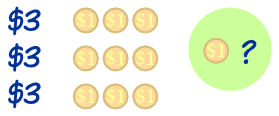Long Division - Introduction
![]()
John and Ann are given $10 to share. How do they share it? Easy! $5 each.

But then they think of their little baby brother Max.
"Maybe we should share it with him?" they ask each other.
So how much do they each get?
$10 shared amongst 3 people
That is $3 each ... but 3 lots of $3 is $9:

That leaves $1 still to share.
Let us break that $1 into ten 10c pieces:

OK. Let's share those 10 cent pieces. That is an extra 30 cents each:

But that still leaves 10c !!!
So let us turn the 10c into ten 1c pieces:

OK, share that too: they each get 3c more:

That leaves one cent! But we can't break that cent any further so it
is simply "left over", which we call the "remainder"
The answer is: they each get $3 and another 30c and another 3c for a totsl of $3.33 each, with one cent left over!
$3.33 each (with a remainder of 1c)
And ...
That is how Long Division works!
In Long Division we:
- do the best division we can,
- then discover what is left over, and try to divide that,
- around and around until we can't go any further!
It is Written Down in a Special Way
First, we write down that we want to divide $10 by 3 like this:
Note: We don't use the $ symbol, instead we write
the $10 as the number 10.00 meaning 10 dollars and 0 cents
Then we write down that we took 3 lots of $3 to make $9:
We write the 9 below the 10, because the next thing to do is to subtract $9 from $10 to find we still have $1 left to divide:
Next is to repeat the whole thing, but do it for the $1 (which is written as 1.00):
That leaves 10 cents, or 0.10 yet to divide, so we repeat again:
We can't divide any more, so that is our answer!
$10 divided by 3 is $3.33 with $0.01 (1 cent) remainder
Now have a look at this Long Division Animation